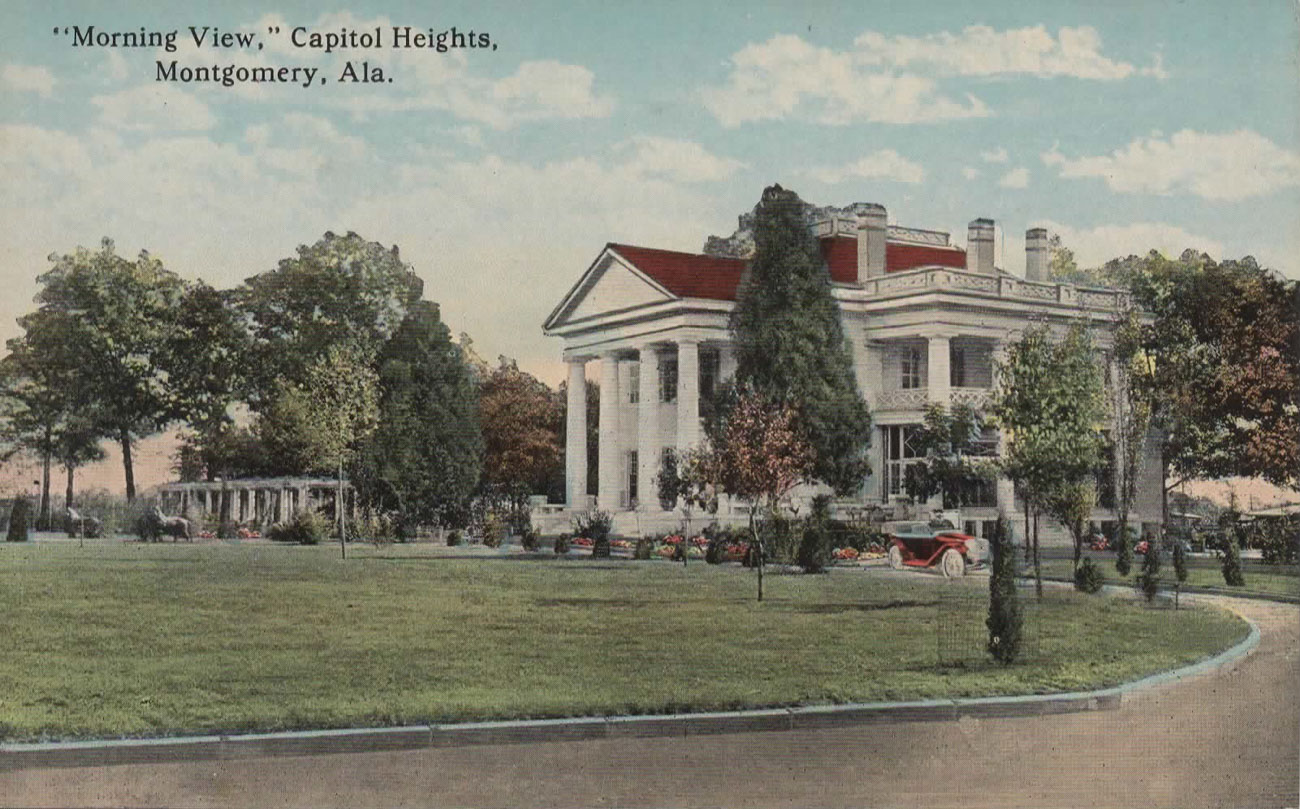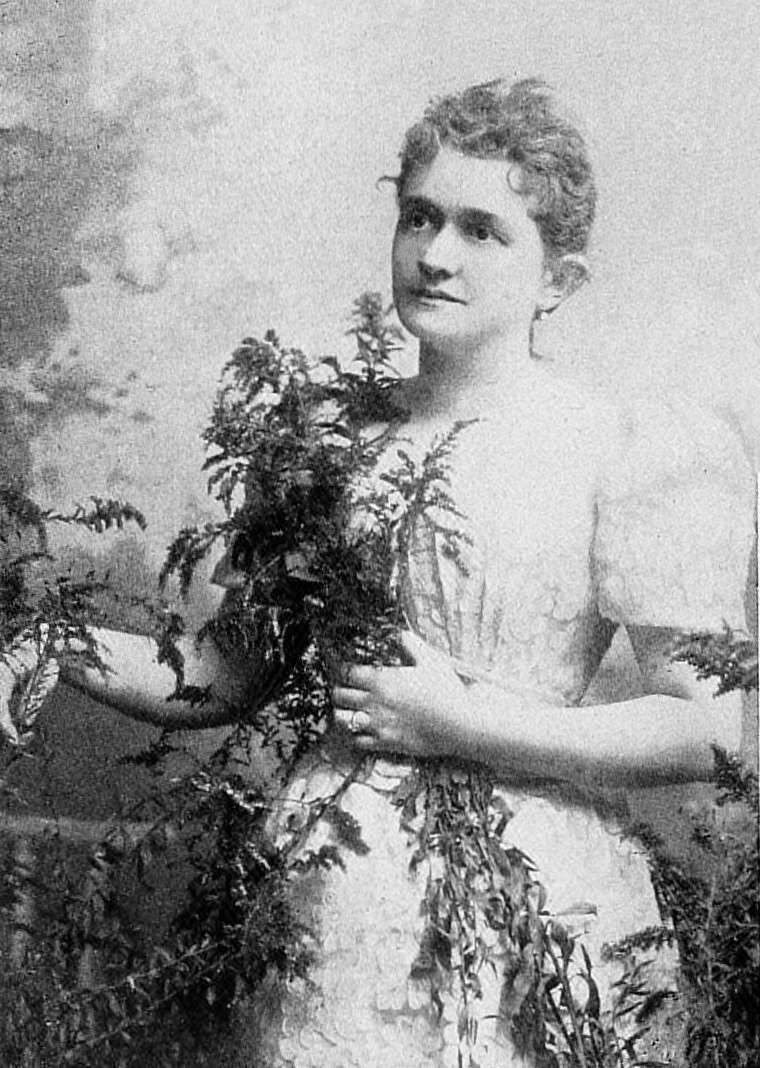| City/Town: • Montgomery |
| Location Class: • Residential |
| Built: • 1906 | Abandoned: • 1975 |
| Status: • Burned Down |
| Photojournalist: |
Table of Contents
Gen. Mitchell B. Houghton
Mitchell Bennett Houghton was born on September 14, 1844, the son of William Henry and Elizabeth Ann Bennett Houghton. In July 1861, he enlisted in Newton, Alabama in the Confederate Army at sixteen years of age. Sixteen volunteers, including Houghton, formed Company “H”, known as the “Glenville Guards” in Glenville, Alabama. The Glenville Guards joined other companies at Fort Mitchell, about nine miles below Columbus, Georgia, on the Alabama side and the resultant regiment became known as the 15th Alabama Infantry Regiment. The regiment was sent to Virginia and arrived about one month after the Battle of First Manassas and became part of General Robert E. Lee’s Army.
In the summer of 1862, Houghton was seriously wounded in the head above the right ear by an exploding artillery shell fragment. He was hospitalized but received little medical attention. Due to the seriousness of his injury, he was expected to die.
Houghton eventually recovered sufficiently to rejoin his regiment and participated in the assault on Little Round Top in Gettysburg against the 20th Maine Infantry Regiment. The 15th Alabama’s assault failed and out of 644 men engaged from the 15th Alabama at the Battle of Gettysburg, the regiment lost 72 men killed, 190 wounded, and 81 missing.
Houghton wrote that one of the saddest sights he ever witness was on the field of Gettysburg. Among the hundreds of dead and mutilated corpses, he saw a soldier with a North Carolina mark on his cap leaning against a fly tent. An artillery shell fragment had struck him above the breast bone, ripping open his chest and exposing his heart and other organs “which were still in motion and he seemed alive and conscious.”
Afterward, the 15th Alabama was sent west to bolster the Confederate Army of Tennessee under General Braxton Bragg, participating in the Battle of Chickamauga. About 2 weeks after the Battle of Chickamauga, Houghton was captured at Lookout Mountain and was sent to Camp Morton, Indiana where he was held as a prisoner of war. Although many prisoners at Camp Morton died of disease or slow starvation, after 16 months Houghton was exchanged in late 1864, and eventually made it home.
After the war, Houghton engaged in the mercantile business in Union Springs and was one of the organizers of the Bullock County Bank and the Senate Bank of Montgomery, serving as an officer of both banks before engaging in planting and real estate. He organized the Commercial and Industrial Association of Montgomery; served as President of the Board of Revenue of Montgomery for four years; served as Chairman of the Democratic Executive Committee of Bullock County; and was Commander of the Tennessee Division of the United Confederate Veterans.
In 1912, Mitchell Bennett and his brother, William Robert Houghton, published “Two Boys in the Civil War and After” memoirs of their service in the Confederate Army of Northern Virginia. Mitchell died on November 4, 1925, at the age of 81 and is buried at Greenwood Cemetery in Montgomery.
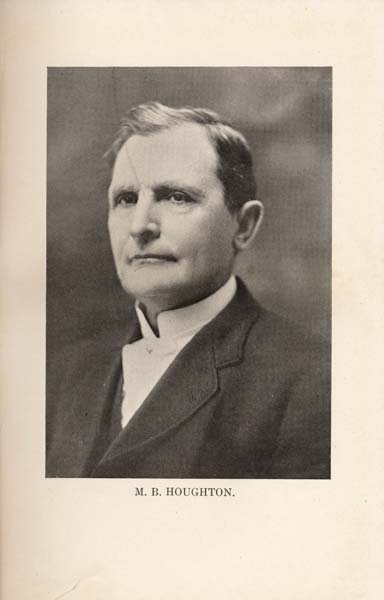
Morning View Estate
In 1906, General M. B. Houghton constructed a palatial mansion on the eastern edge of the newly-incorporated city of Capitol Heights. According to Carole King, curator for the Landmarks Foundation of Montgomery, local legend and architectural evidence indicates that Morning View was built around and over an existing one-story house with a brick floored basement.
The Montgomery Advertiser published a multi-page article on December 11, 1910, written by Marie Bankhead Owen, director of the Alabama Department of Archives and History, titled “MONTGOMERY’S CLASSIC AND BEAUTIFUL HOMES With Graphic Description of Their Interior Decorations, Furniture, Heirlooms, and Works of Art.” The article featured extensive and detailed descriptions of various homes in Montgomery including J. S. Pinckard’s “Rockhaven,” the Governor’s Mansion which at the time was home to Robert F. Ligon Jr., and Houghton’s Morning View estate.
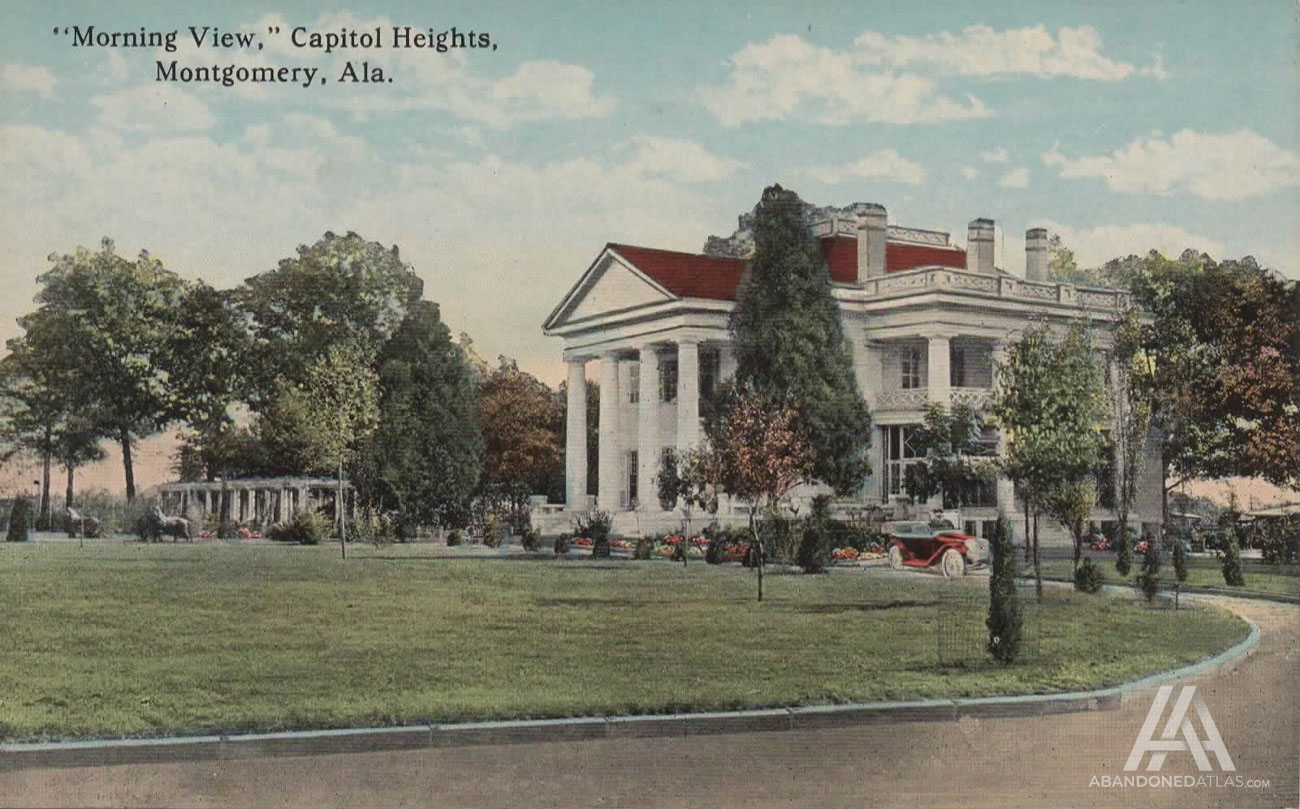
The mansion’s stairway was described as being “of mahogany and white spindles hints of the old Virginia manor houses, and cheerful light silts through the gold-toned art windows that are placed in the wall above the landing of the stairs. Upon the newel post is a bronze figure of Mercury holding a torch, and nearby is a tall grandfather clock that chimes and hours and halves, generously throwing in the quarters, for good measure. In a bronze vase are blossoms of crimson poinsettia, and there is also a Colonial seat with [a] long mirror above.”
The dining room of Morning View was furnished with “massive clawfoot mahogany of Colonial design. There are tapestries here, one of particularly beauty being a garden scene at Versailles during the days of Marie Antoinette. The lace curtains are over-draped with oriental hangings and the lights come from a square canopy of russet tones over the hospitable table.”
The sitting room was “tinted the pink of an Alpine glow, and the finishing is of walnut, a wood once so popular throughout the South, and already restored to rivalry with mahogany in the eastern centers of taste. Here are bookcases, a huge globe, patriotic pictures and landscapes of lake, and stream, and forest in this room.” Inside the drawing room was the crown jewel of Morning View, a white marble mantelpiece with marble columns that touched the ceilings and carved Corinthian caps. The walls of this room were tinted green, as were the carpet and the velvet upholstery of the mahogany furniture. This room also featured a large portrait of Mitchell B. Houghton and a mahogany Edison phonograph.
The mansion’s sun parlor was reached through the drawing room, and was a glass-enclosed verandah furnished with green wicker with red cushioned seats. On the center table was a brass vase containing red chrysanthemums surrounded by potted ferns and palms. It was here where Morning View got its name. Where one could view the sun rising in the west casting its golden light across the hundreds of acres of crops and farmland surrounding the estate.
Houghton took pride in his orchards and poultry yards. His livestock was composed of chickens, ducks, turkeys, peafowls, pigeons, pheasants, doves, geese, partridges, rabbits, squirrels, pigs, cows, horses, and opossums. His orchard contained apple, pear, plum, chestnut, chinquapin, pecan, and date trees. In his vineyard were scuppernong, concord, and Delaware grapes. In the woodland dell near the house, one could find various specimens of trees, vines, shrubs, and flowers including oak, dogwood, honeysuckle, magnolia, haw, pomegranate, and violet.
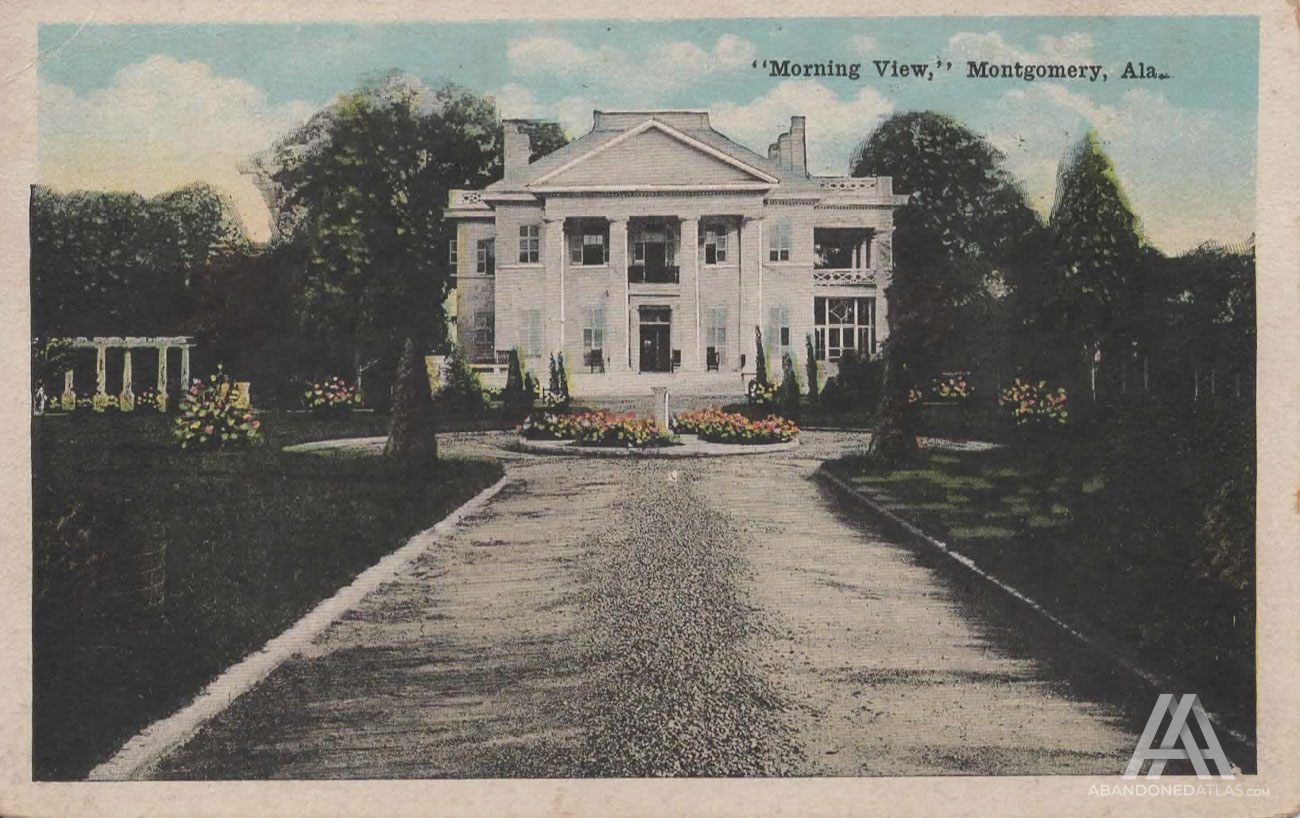
“At Morning View”
Kate Slaughter McKinney was an author and poet who used the pen-name of Katydid. She was born on February 6, 1859, in London, Kentucky, the daughter of James Love Slaughter and Lucinda Jane Price. Her great-grandfather on her father’s side was Kentucky Governor Gabriel Slaughter. On her mother’s side, she was the great-granddaughter of Kentucky Governor James Garrard and the grand-niece of Union Brigadier General Theophilus T. Garrard.
Katydid wrote verses since she was fifteen years of age. The first were published in The Louisville Courier, from which they found a way into the leading newspapers and magazines. She was said to have a lyrical gift, and her poems had melody and sweetness. In 1931, she was elected Poet Laureate of the State of Alabama. Her published works include Katydid’s Poems (1887), A Tale of a Kentucky Tragedy (1906), The Weed by the Wall (1911), and Palace of Silver (1927).
On May 7, 1878, she married James Isaac McKinney, superintendent of the Louisville and Nashville Railroad in Montgomery, Alabama. Due to her love of cultivating flowers and the local fauna, she joined the Montgomery Flower Growers Association which was established in 1907. On May 2, 1908, members of the Flower Growers Association were entertained at Morning View, including Katydid, who wrote a poem inspired by her visit to the grand estate titled “At Morning View” which was published in the Montgomery Advertiser on May 5, 1908.
Just between the city’s din
And the long lake shining blue
In the clustered, quiet trees
Is the home of “Morning View.”
And the pheasants live out there
And we hear the ring doves coo.
Oh, the breeze is fresh and sweet,
And the grass is smooth and low,
And the little ducks are seen
Winding like a booklet’s flow,
And the peacock spreads his tail
That his beauty all may know.
There the almond trees are seen,
And the red raspberry too,
And the rippling, rippling grain
Where the birds feed—not a few;
Everything is happy, happy,
Out at lovely “Morning View.”
And I was happy, happy,
Till I heard the martin’s sing,
Till the swallow floating over
Spoke to me in words of spring—
Of a home that is now vanished
And that only memories bring.
Out at “Morning View” the roses
Speak in perfume to the air,
And a saintly white cape jesamin
Tells of Browning’s poem there—
Of a lovely, angel woman,
With a blossom in her hair.
More there is for higher vision,
More at “Morning View” to hear;
All is sweetly intermingled
Like a blessing with a tear,
Like a smile of Heaven weary
And that makes the earth so dear.
“Present and Past in the Cradle of Dixie”
In February 1914, Morning View played a rather large role in the 1914 motion picture, “Present and Past in the Cradle of Dixie.” The film was designed to both commemorate the Civil War’s fiftieth anniversary and demonstrate a spirit of reconciliation between the North and the South. It was produced by the Paragon Film Company of Omaha, Nebraska, and the work was overseen by Oliver William Lamb. Filming began on February 23, 1914, and the premiere was held a month later at the Grand Theatre on March 25.
The cast consisted of notable Montgomery citizens such as Dr. Robert Goldthwaite, grandson of George Thomas Goldthwaite; Clifford Alexander Lanier Jr., nephew of Sidney Lanier; William Adams Gunter II, Mayor of Montgomery; Gaston Gunter, former Mayor of Montgomery; Judge John Pelham, son of U.S. Congressman Charles Pelham and nephew of Confederate war hero, Major John Pelham; Captain Robert Tyler Goodwyn Sr. as Jefferson Davis; Alabama Governor Emmet O’Neal as himself; and General Mitchell B. Houghton as Colonel William Fairfax Harrison.
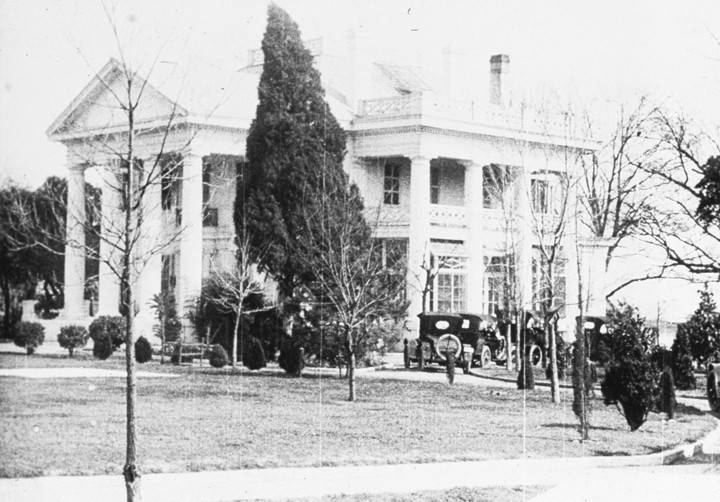
The plot of the film involves Bertram C. Lawton, a young man from the North who dreamt of finding the love of his life in “The Cradle of the Confederacy.” He arrives in Montgomery for a house party held at Morning View, ignorant of the fact that he also arrived on the occasion of the fiftieth anniversary of Jefferson Davis’ inauguration. He meets the woman from his dreams, Elinore Harrison, who invites him to attend the social functions of the day.
At the Alabama State Capitol, Governor Emmet O’Neal delivers a speech about the stirring days of the early 1860s, beginning with the convention that resulted in the adoption of the Ordinance of Secession on January 11, 1861. A series of flashbacks play out, reenacting historic events such as the inauguration of Jefferson Davis and the adoption of the first flag of the Confederacy, leading up to the decision to fire upon Fort Sumter.
Back at Morning View, Bertram and Elinore dance together before going to the rose garden where Bertram proposes to her—she says yes. Her grandfather, Colonel Harrison, objects to the marriage and orders Bertram away. He returns to steal her away, only to find Morning View on fire and Elinore screaming for help from a second-floor window. Bertram rushes inside and saves her just as firefighters arrive. Colonel Harrison reconciles with the two sweethearts ending the movie with, “Bless You, My Children.”

Notable Employees
Cornelius “Darnley Beaufort” Betz
According to an article published in the December 11, 1910 issue of The Montgomery Advertiser, Houghton employed Cornelius Betz, a Hollander who claimed to have been in the employ of old-world royalty for fifteen years, having begun service as a page to Princess Frederick of Holland and later for her mother-in-law, the dower Princess of Wied. She was the mother of Elisabeth of Wied, the first queen of Romania.
Betz also claimed to have toured the world with the Duke of Edinborough and made a separate trip around the world with Prince Fritz of Waldeck and Pyrmont, the uncle of the Queen of Holland. After the death of the Princess of Wied, Betz came to America and invested his life savings in industrial enterprises that lost him a fortune.
The truth though is that Cornelius Betz was born in Bourscheid, Luxembourg born in 1858. He was raised near Beaufort Castle but was not related to the Beaufort family. He adopted the name “Darnley Beaufort” sometime around 1890 while operating confidence schemes in England and Switzerland. He was fluent in four languages (English, German, French, and Italian), wore the clothes expected of a member of England’s upper class, and appeared to be highly educated.
He arrived in Kentucky in 1892, claiming that he was a recent convert to Catholicism, that his wife had recently abandoned him and that his 12-year-old son recently died. Betz claimed that his son’s dying wish had been for his father to spend his vast fortune on helping poor children. Operating under the name Darnley Beaufort, he served as principal of Gethsemane College, a school operated by the Abbey of Our Lady of Gethsemane in Kentucky, from 1893 to 1895. Shortly after being placed in charge of the school, complaints about his conduct with students and the Abbey’s funds followed soon followed.
By October 1894, the New York Times reported that “Beaufort” was an assumed and fraudulent identity, and newspapers in Chicago reported that he was mistreating students; nonetheless, he remained employed as the principal at Gethsemane College. It wasn’t until the Abbey discovered a substantial financial shortage in August 1895 that “Beaufort” was terminated. He revisited the school in October 1895 to secure proof from the abbot that he was Beaufort. He was escorted by three me who identified themselves as detectives from Cincinnati, Ohio, and had arrested Beaufort under the name “Elridge.” It was later found that the detectives were frauds and the arrest story was fabricated, leaving the real reason for their visit a mystery.
Soon after Beaufort’s termination, allegations that he sexually abused boys at the school son followed, and was charged with six counts of “gross immorality” with boys in his care, representing acts with six different students. He was convicted of the first count on April 12, 1896, and sentenced to 30 days in jail and a $200 fine. He was convicted of the second charge one week later and fined one cent. The Nelson County, Kentucky prosecutor declined to pursue the remaining four charges. Beaufort remained in Kentucky until February 1898, and it wasn’t until he arrived in Alabama in 1910 that he reverted back to his birth name.
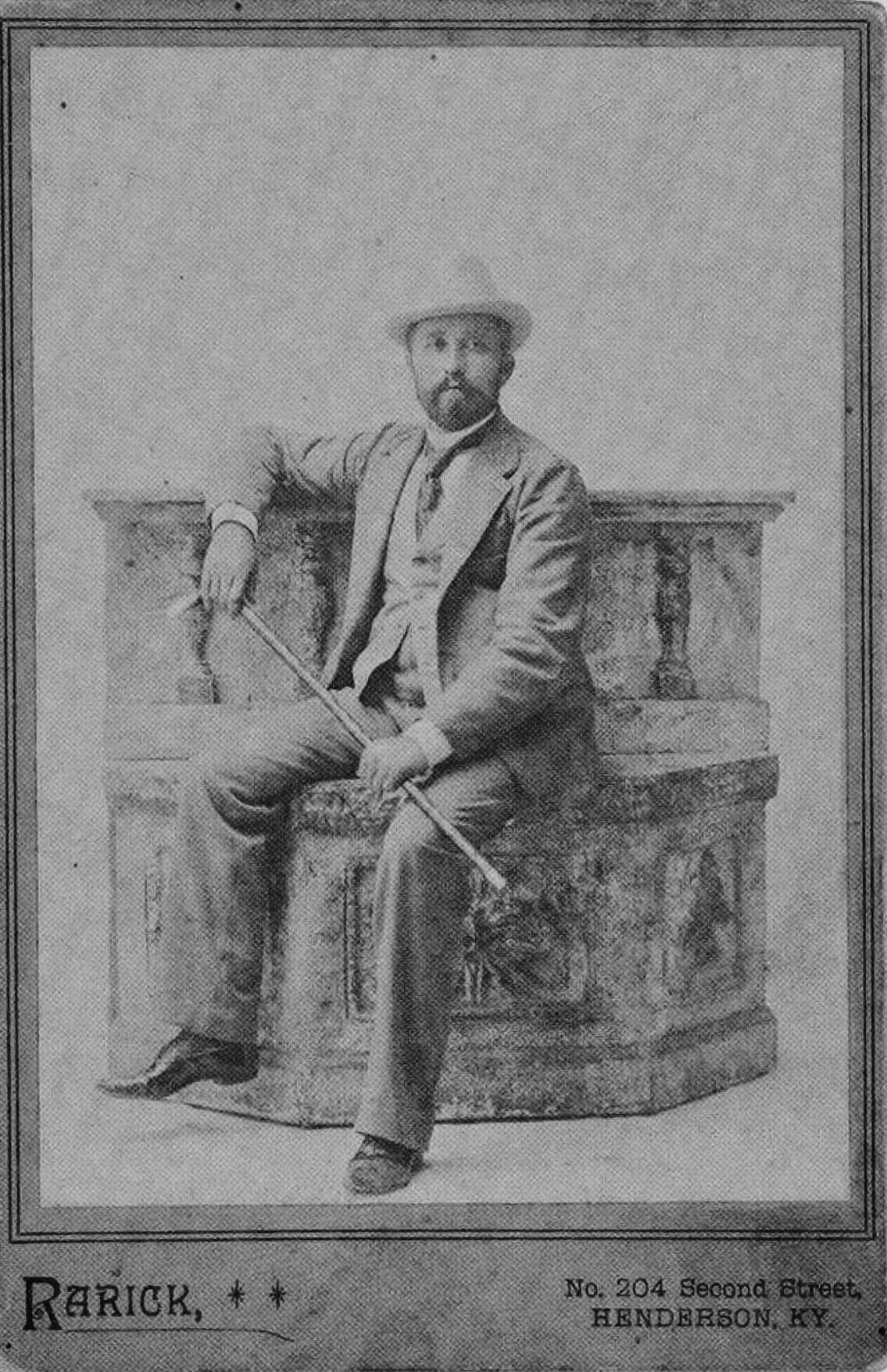
Frank Browne
Frank Browne, a native of England, was Houghton’s head gardener at Morning View for many years and later for the Ray Rushton family on South Hull Street. According to Joe Johnson, a Capitol Heights historian, Browne could often be found walking about Capitol Heights inspecting the flowers and plants at various homes. He took a special interest in Capitol Parkway since, at the time, individual property owners were responsible for maintaining the parkway in front of their homes.
Due to his manner of dress and lifestyle, everyone assumed Browne’s financial situation was bordering on poverty. According to an article in the July 29, 1945, issue of The Montgomery Advertiser, “he usually lived on the premises in servant quarters. He never married or had any of the comforts or joys of home life, nor did he cultivate friends. He was never known to own an automobile, a horse or buggy, or go to a show to seek any recreation whatsoever, to spend a dime that could be saved.” After a very brief illness, he died on July 13, 1940, in a boarding house with few personal possessions that were worth no more than $5.
After his death, it was found that the reclusive and destitute old man was quite wealthy, leaving behind an estate valued at $169,000. Browne owned considerable real estate and war bonds in America and had money in Lloyd’s Bank in Sleaford, England. It was said that he would walk for miles to see real estate purchases made now and then rather than spend money on bus fares. With the exception of $5,000 to his sister in England, his large estate was willed to Dr. Bernardo’s Homes, a system of orphanages also in England. His grave in Oakwood Cemetery in Montgomery is inscribed with the words, “A SON OF OLD ENGLAND.”
Following Houghton’s Death
M. B. Houghton left a will in which, after making certain bequests to family members, he left the remainder of his estate valued at around $250,000 to the Houghton Educational Society, a trust formed for educational purposes by demonstrating improved methods of agriculture, horticulture, and floriculture at Morning View. This school and its assets would be operated by the Woman’s College of Alabama, of which he was one of the founders.
This bequest was made in memory of his father, Colonel William H. Houghton, and his brother W. R. Houghton who died in 1906. His nephew Harry Streety Houghton, his brother’s son, was made executor of this will.
In November 1926, Mrs. L. D. Brooks of Austin, Texas, a sister of the late M. B. Houghton filed a lawsuit alleging that the trust created by Houghton was not a charitable trust which violates the Alabama laws against perpetuities. Judge Walter B. Jones sided with Brooks and ordered that Houghton’s properties be sold at a public auction on March 26, 1928, held at the Court Square Fountain.
In lieu of his uncle’s original bequest, Harry Houghton donated $70,000 to the Women’s College for the construction of a library that was to be named after his uncle. Construction of the Houghton Memorial Library was completed and occupied by May 1, 1930, and is listed on the National Register of Historic Places as part of the Huntingdon College Campus Historic District.
From 1930 to the early 1940s, Harry S. Houghton and his wife resided at Morning View but it’s not known if they had purchased the home themselves at auction as the home was also occupied by Mr. and Mrs. C. W. Cromwell. Clarence White Cromwell was a prominent lumberman who established the Cromwell Hardwood Lumber Company in McBain, Michigan with his father and brother in 1891. The lumber business moved to Jackson, Mississippi in 1909 and expanded into Montgomery in 1910.
According to his obituary, Harry S. Houghton died on June 22, 1940, at his home in Morning View where funeral services were later held.
On November 16, 1940, a soldier passing by Morning View witnessed the roof “explode into flames” and sounded the alarm. Fire companies from Scott Street and Highland Avenue responded to the call and controlled the fire within 20 minutes upon arrival. It was believed that a hot electric wire in the mansion’s rafters was the cause of the fire. Damages were estimated to be several thousand dollars. It can be assumed that Cromwell moved out due to the fire and later died at his home at 507 Norman Bridge Road on April 16, 1942.
Bessie Ware Walker
Bessie Ware Walker was born on February 4, 1884, the daughter of Captain Henry Tabb “Hal” Walker and Eliza Ware Walker. Her father was said to have been the first male child born in the White House in Washington D. C., the great nephew of President James Knox Polk. During the Civil War, he served on the official staff of Generals Joe Wheeler and Frank C. Armstrong and was appointed Commander of the Tennessee Division of the United Confederate Veterans following the death of M. B. Houghton.
Walker’s wife Eliza was the granddaughter of Robert Ware, one of the 17 Revolutionary soldiers who first settled in the city of Montgomery. The family’s plantation was located where the Seton Haven Nursing Home now stands with the only remnant being the family cemetery which is still maintained on the property. The Ware family also operated a ferry used on the Alabama River, hence the name Wares Ferry Road. Eliza was also the niece of Elizabeth Ware Cowles, the wife of Thomas Meriweather Cowles who owned a plantation at the end of Wares Ferry Road.
It’s assumed Bessie Ware Walker inherited her family’s land interests after the death of her parents, although it’s uncertain when she acquired the Morning View mansion. Located about a mile from Morning View, her family’s land was once the location of Electric Park, one of Montgomery’s most charming spots.
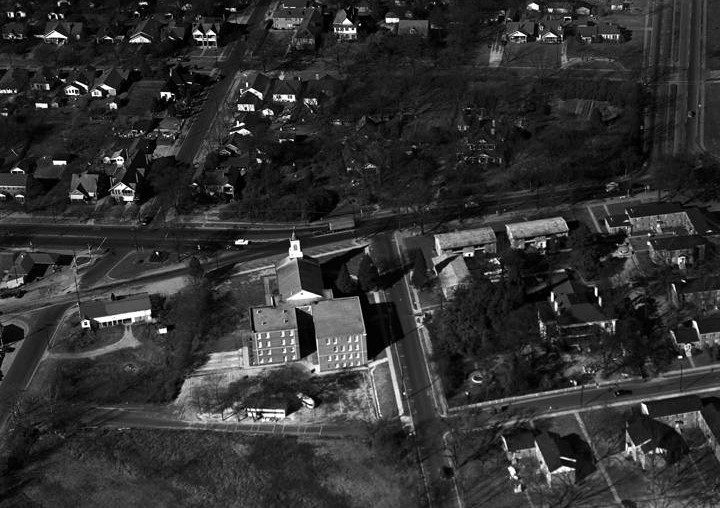
Electric Park
In the early 1900s, one of the major attractions Montgomery had to offer was an amusement park called Electric Park, located in what is now known as Forest Hills. The main attraction of the park was a large lake located where the Forest Hills Shopping Center now stands. It was said that most of the Montgomery men in those days courted their future wives while boating on Electric Park lake. The park was popular for Sunday family picnics, and Ferris wheels, merry-go-rounds, and the usual amusement features were available for entertainment.
The park started out as Bloemfontaine Park, named after the town it was located. In 1902, the state Legislature passed a bill authorizing a municipal government for a town to be called Bloemfontaine, located along the Three Mile Branch on Atlanta Highway, three miles from the city of Montgomery. According to historian Carolyn Wright, Hal T. Walker, the owner of the land where the park would be constructed, was elected mayor. “Other officers and citizens of the town were R. F. Scott, H. A. Goldthwaite, Thomas W. Oliver, J. W. A. Sanford, B. H. Screws, and James S. Fuller.”
By the time the town was chartered, plans were already underway for an amusement park near the lake. A pavilion and theater had been built but due to a lack of funding for improvements to the lake, it was left unfinished. The Montgomery Street Railway constructed a mile and a half of new tracks to the park, connecting it with their Highland Park line. Francis E. Ayres managed the park and the two entities operated independently—an arrangement that was said to have been unsatisfactory.
The park formally opened on July 4, 1902, and was popular among the residents of the city but was plagued with problems right from the start, mainly having to do with the lake. Residents of Bloemfontaine complained of unsanitary conditions at the lake with one claiming that he had contracted malaria due to the conditions.
The following year, it was announced that the park was purchased by the Montgomery Street Railway and that work had begun “to improve and beautify the place.” The park reopened to the public on September 10, 1904, and was renamed “Electric Park” due to the 12,000 incandescent lights and 150 arc lights that illuminated the area during the evenings. Montgomery gained fame as the home of the very first electric streetcar system in the Western Hemisphere and the park’s large display of electric lighting bolstered the city’s image of innovation.
Electric Park also featured a figure-8 roller coaster, a carousel, a penny arcade filled with the latest penny-in-the-slot devices, a “laughing gallery” similar to Temple of Mirth at the St. Louis World’s Fair, and a new streetcar station. The lake featured a fleet of row boats, swan boats, and two-masted sailboats. The park had its own waterworks which were fed from an artesian well. This came at no charge to the people of Montgomery, although visitors usually came by streetcar which cost ten cents per round trip.
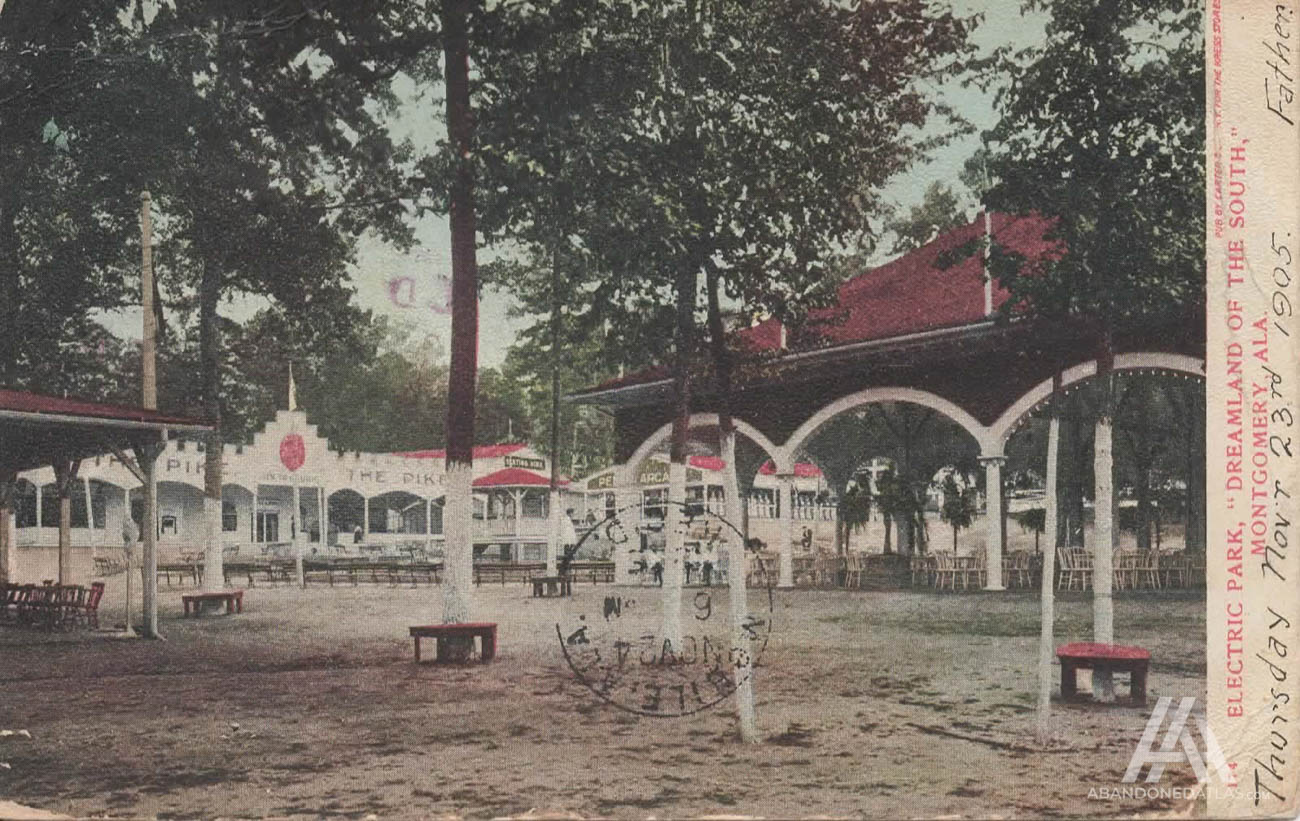
The Montgomery Traction Company was an opposing streetcar company that attempted to build a rail line into Electric Park. The Montgomery Street Railway obviously opposed this action, filing a lawsuit against the Traction Company claiming that they had spent $75,000 on improvements to the park and that the Traction Company had no right in reaping the rewards in an endeavor they did not invest in.
The Traction Company argued they did indeed have the right as the lease to the land owned by Hal T. Walker contained a caveat that allowed the construction of street railways and did not give exclusive control of the property. After a long drawn-out court battle, Judge A. D. Sayre sided with the Traction Company.
The two companies were highly competitive and always at odds with one another, going as far as tearing up tracks and engaging in street fights with the opposing labor force. In one instance, Richard Tillis, President of the Montgomery Street Railway, was arrested for deliberately wrecking a street car in order to prevent the Traction Company from continuing work. In the interest of the public, an agreement was reached and the Montgomery Street Railway was purchased on December 15, 1905, and consolidated into the Montgomery Traction Company, giving them full control of the city’s streetcar railways and Electric Park.
Despite this compromise, Electric Park still suffered from issues regarding the lake’s dam which broke on numerous occasions. It all came to a head in April 1908 when it was reported that “Old Pap,” a “well-known old Negro” living near Electric Park fell into the water and drowned while watching the flood over the broken dam. In 1909, the decision was made to close the park and relocate its rides and other attractions to another park the Traction Company owned called Pickett Springs, located in North Montgomery near the company town of Boylston.
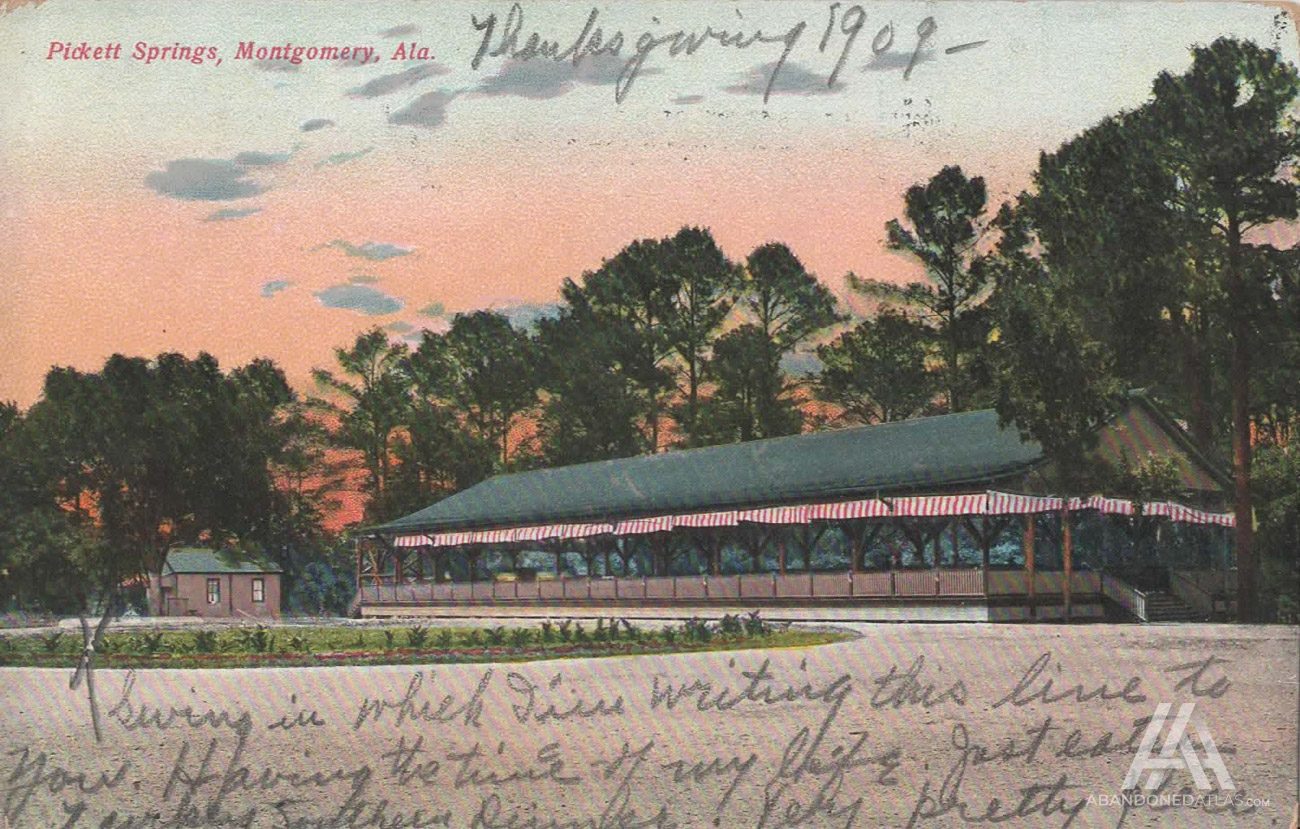
Morning View Burns Down
In the early morning of December 31, 1975, a fire destroyed Morning View which had been vacant at the time and recently purchased by T. L. Thaggard. At the time, the house was valued at $25,000. Thaggard was a businessman who was remembered at the time for being sentenced to five years in prison for mistakenly receiving $43,000 from his bank and refusing to return it. By this time, the property was split into separate parcels with apartments built on what was the mansion’s front lawn.
Fire officials deemed the fire suspicious with the most probable cause being arson. According to burn patterns found at the scene, the fire likely started on the house’s upper level. It was reported that teenagers would often stay overnight and sleep on mattresses scattered upstairs. There was also no electricity in the house, thereby ruling out the possibility of a short circuit causing the blaze.
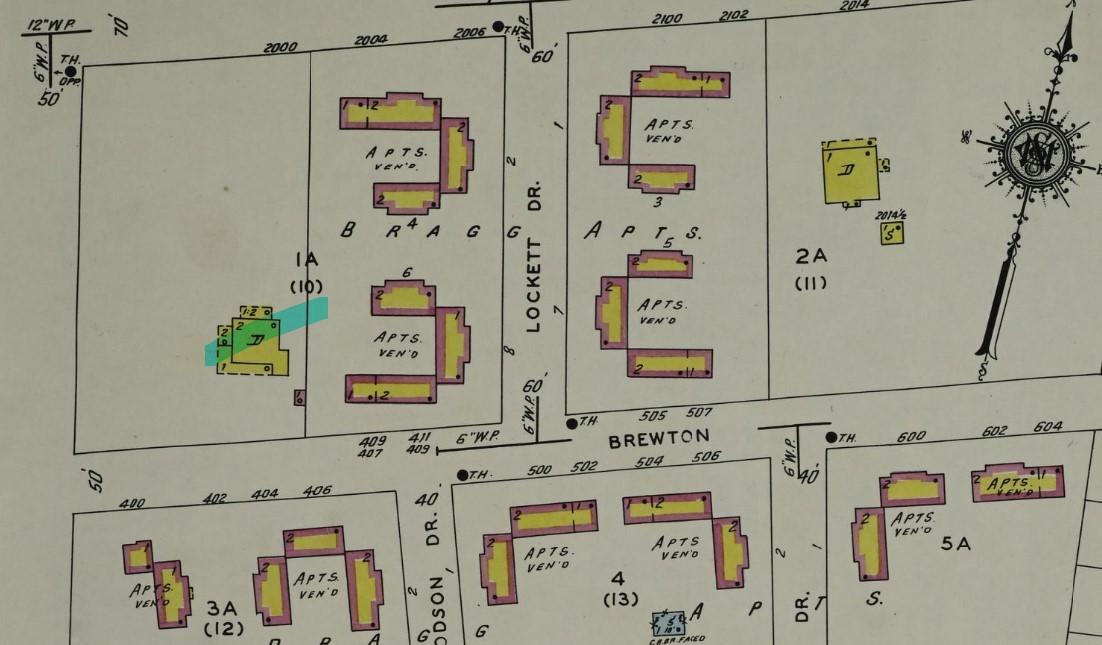
The Lions of Oak Park
A pair of life-size cast iron lions can be found at the Montgomery Botanical Gardens in Oak Park which were donated to the city by Anton Haardt and Haardt Moses. The lions were acquired by Anton’s father John Hall Haardt, a successful real estate developer and civic leader. In addition to being a developer, Haardt often bought and kept architectural relics from older homes that were demolished or sold for salvage.
Haardt also collected antique furniture and decorations, moldings, floorings, doorknobs, marble, doors—anything he found interesting. He stored these antiques in his office at the Rice-Semple House before relocating them to the Moses House at 670 South Perry Street. Although Anton is unsure when her father acquired them, she theorizes that he purchased them directly from Bessie Ware Walker at some point, either to help raise money to care for Walker or just because he wanted the statues.
Walker was a close friend of the Haardt family who would often visit “Miss Bessie” at Morning View. In an article published in the August 25, 2013, issue of The Montgomery Advertiser, Anton recalls Walker being a colorful figure who sat “in this big wicker chair on the second floor with this big cat. And she had the most Southern accent.“Anton also remembers visiting her up until about 1975, around the time the house was sold and subsequently burned down.
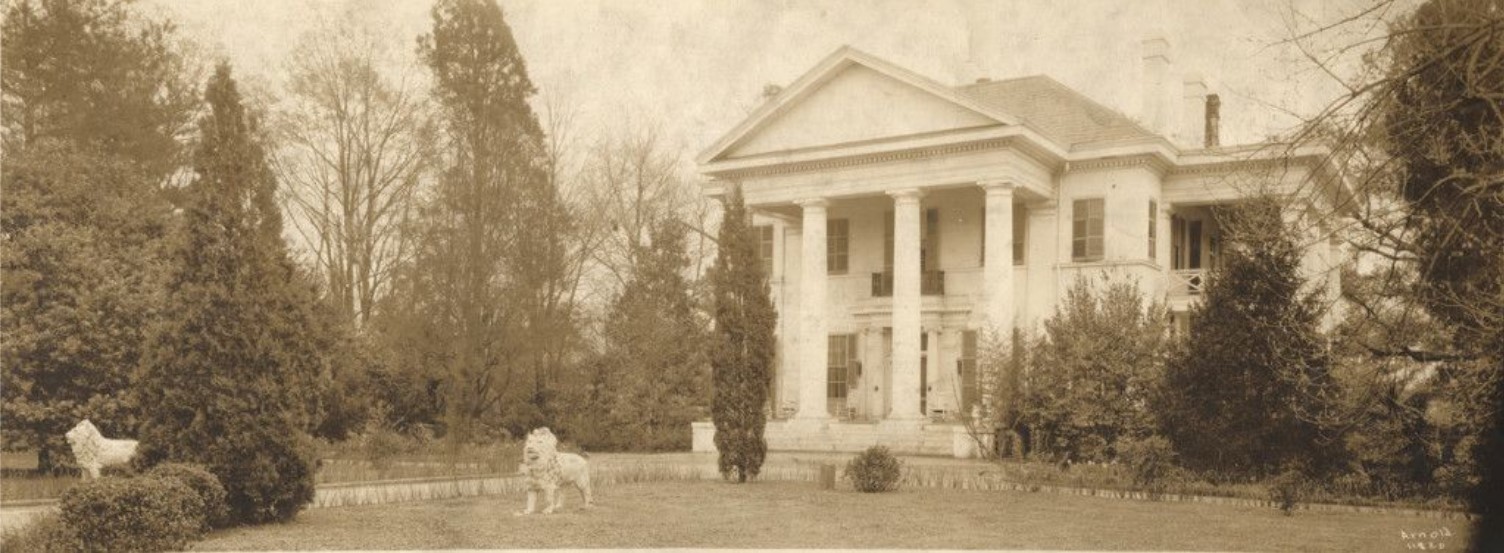
The lions were cast by the Robert Wood Foundry in Philadelphia, Pennsylvania sometime in the 1860s, and guarded the Haardt home at 44 South Haardt Drive for more than 50 years. Before the Haardt house, the lions stood at Morning View, although the lions don’t appear in photographs or postcards until the early 1910s. Considering their age, there is also the possibility that the lions stood elsewhere before they were brought to M. B. Houghton’s estate.
Two small columns can also be found at a residence in Edgewood, said to have come from Morning View which flanked the mansion’s driveway. The mansion’s fern pit, used for storing porch plants in the winter months, can still be found in the parking lot of the Ann Street upholstery shop. Though not much remains of Morning View, large cedar trees, assorted magnolia, and other hardwoods still stand tall at what was once described as one of the most beautiful places in Montgomery.
References
The Montgomery Advertiser; Kate Slaughter McKinney. (May 5, 1908 p. 4). “At Morning View”
Alabama Authors. (retrieved August 30, 2022). McKINNEY, KATE SLAUGHTER, 1859-1939
Alabama Journal. (December 31, 1975 p. 23). Arson Is Suspected In Mansion Fire
The Montgomery Advertiser; Mildred Smith. (July 29, 1945 p. 11). Frank Browne’s Estate Settled; Cultured Recluse Left $169,000
The Montgomery Advertiser; Marie Bankhead Owens. (December 11, 1910 p. 17). MONTGOMERY’S CLASSIC AND BEAUTIFUL HOMES With Graphic Description of Their Interior Decorations, Furniture, Heirlooms, and Works of Art.
Midtown Montgomery Living; Carole King. (July 20, 2012). A Vanishing Morning View
The Montgomery Advertiser. (December 3, 1926 p. 8). HOUGHTON’S WILL TO UNDERGO TEST
The Montgomery Advertiser; Allison Griffin. (August 25, 2013 p. E1). Preservationists seek new home for Morning View lions
The Montgomery Advertiser. (February 24, 1914 p. 1). HISTORIC SCENES OF MOTION PICTURE TO BE MADE TODAY
The Montgomery Advertiser. (March 22, 1914 p. 23). MONTGOMERY MOVIE ENTHUSIASTICALLY RECEIVED BY ULTRA-CRITICAL CENSOR BOARD SATURDAY
Alabama Department of Archives and History. (retrieved September 15, 2022). Materials related to “Present and Past in the Cradle of Dixie,” a film sponsored by the Business Men’s League of Montgomery, Alabama
The Montgomery Advertiser. (November 17, 1940 p. 5). Blaze Damages Cromwell Home
The Montgomery Advertiser. (June 23, 1940 p. 1). H. S. HOUGHTON SUCCUMBS AT MORNINGVIEW
The Weekly Advertiser. (March 27, 1902). AT BLOAMFONATINE, STREET RAILWAY HAS ACQUIRED PROPERTY
The Montgomery Advertiser. (September 4, 1904). NEW PARK OPENING
The Montgomery Advertiser. (July 6, 1905 p. 7). TRACTION COMPANY AVERSPARK COMPANY IS A “DUMMY”
The Montgomery Advertiser. (May 14, 1905 p. 21). CAR COMPANY ENJOINED
The Montgomery Advertiser. (April 29, 1908 p. 5). DEATH AT THE LAKE
The Montgomery Advertiser. (January 25, 1906 p. 3). STREET RAILWAYS
The Montgomery Advertiser. (August 23, 1902 p. 9). WILL CLEAN THE LAKE; BLOEMFONTAINE TO BE PUT IN SANITARY CONDITION
The Montgomery Advertiser; Carolyn Wright. (February 8, 2014). Looking back: Families enjoyed city’s Electric Park

